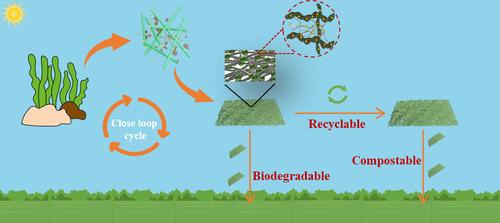当前位置:
X-MOL 学术
›
ACS Sustain. Chem. Eng.
›
论文详情
Our official English website, www.x-mol.net, welcomes your
feedback! (Note: you will need to create a separate account there.)
Conversion of Macroalgae into Environmentally Friendly Bioplastics by Noncovalent Bond Assembly
ACS Sustainable Chemistry & Engineering ( IF 7.1 ) Pub Date : 2024-11-08 , DOI: 10.1021/acssuschemeng.4c07767 Shikai Zhang, Peng Ju, Xiaofei Yin, Hanqi Liu, Bowen Zhang, Houshen Li, Xiangju Meng, Shiyun Ai
ACS Sustainable Chemistry & Engineering ( IF 7.1 ) Pub Date : 2024-11-08 , DOI: 10.1021/acssuschemeng.4c07767 Shikai Zhang, Peng Ju, Xiaofei Yin, Hanqi Liu, Bowen Zhang, Houshen Li, Xiangju Meng, Shiyun Ai

|
In response to the current ecological crisis and oil depletion crisis, the use of macroalgae to produce biodegradable bioplastics that can replace petrochemical materials has attracted widespread attention. Herein, a multiscale interfacial engineering strategy for “in situ regeneration” of lignin is proposed to prepare a Bioplastic using Enteromorpha prolifera biomass components featuring hydrogen-bonding-mediated self-assembly of micro/nano lignin and cellulose micro-/nanofibers into a multistage composite dense layer structure. The prepared bioplastics exhibit good mechanical strength (12.80 MPa), superior to most films prepared from algae and even comparable to some common petrochemical plastics. They have a high water contact angle (94.04°) and do not deform or disintegrate when immersed in water for 60 d, demonstrating excellent hydrophobicity and water stability. Bioplastics can block the entire spectrum of UVB (275–320 nm) and UVC (200–275 nm), as well as most of the UVA spectrum (320–400 nm), providing good UV resistance. Importantly, they are biodegradable, compostable, and recyclable, exhibiting unique closed-loop cycle properties. Finally, the environmental impacts were assessed in terms of global warming potential, ecotoxicity, ozone depletion, and other perspectives through life-cycle assessment, emphasizing the environmental benefits of using macroalgae for bioplastic production. This environmentally friendly Bioplastic can be regarded as a substitute for petrochemical plastics and holds great promise in areas such as packaging materials.
中文翻译:

通过非共价键组装将大型藻类转化为环保生物塑料
为应对当前的生态危机和石油枯竭危机,利用大型藻类生产可替代石化材料的可生物降解生物塑料引起了广泛关注。在此,提出了一种木质素“原位再生”的多尺度界面工程策略,使用 Enteromorpha prolifera 生物质成分制备生物塑料,其特点是氢键介导的微/纳米木质素和纤维素微/纳米纤维自组装成多级复合致密层结构。制备的生物塑料具有良好的机械强度 (12.80 MPa),优于大多数由藻类制备的薄膜,甚至与一些常见的石化塑料相当。它们具有较高的水接触角 (94.04°),在水中浸泡 60 天不会变形或分解,表现出优异的疏水性和水稳定性。生物塑料可以阻挡 UVB (275-320 nm) 和 UVC (200-275 nm) 的整个光谱,以及大部分 UVA 光谱 (320-400 nm),提供良好的抗紫外线性。重要的是,它们是可生物降解、可堆肥和可回收的,表现出独特的闭环循环特性。最后,通过生命周期评估从全球变暖潜能值、生态毒性、臭氧消耗和其他角度评估环境影响,强调使用大型藻类生产生物塑料的环境效益。这种环保型生物塑料可以被视为石化塑料的替代品,在包装材料等领域具有很大的前景。
更新日期:2024-11-08
中文翻译:

通过非共价键组装将大型藻类转化为环保生物塑料
为应对当前的生态危机和石油枯竭危机,利用大型藻类生产可替代石化材料的可生物降解生物塑料引起了广泛关注。在此,提出了一种木质素“原位再生”的多尺度界面工程策略,使用 Enteromorpha prolifera 生物质成分制备生物塑料,其特点是氢键介导的微/纳米木质素和纤维素微/纳米纤维自组装成多级复合致密层结构。制备的生物塑料具有良好的机械强度 (12.80 MPa),优于大多数由藻类制备的薄膜,甚至与一些常见的石化塑料相当。它们具有较高的水接触角 (94.04°),在水中浸泡 60 天不会变形或分解,表现出优异的疏水性和水稳定性。生物塑料可以阻挡 UVB (275-320 nm) 和 UVC (200-275 nm) 的整个光谱,以及大部分 UVA 光谱 (320-400 nm),提供良好的抗紫外线性。重要的是,它们是可生物降解、可堆肥和可回收的,表现出独特的闭环循环特性。最后,通过生命周期评估从全球变暖潜能值、生态毒性、臭氧消耗和其他角度评估环境影响,强调使用大型藻类生产生物塑料的环境效益。这种环保型生物塑料可以被视为石化塑料的替代品,在包装材料等领域具有很大的前景。


















































 京公网安备 11010802027423号
京公网安备 11010802027423号